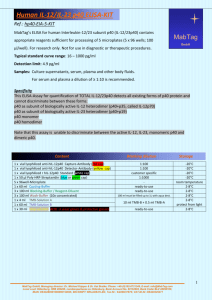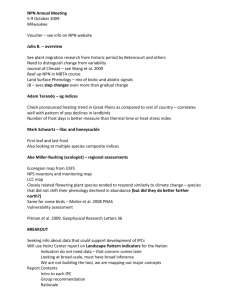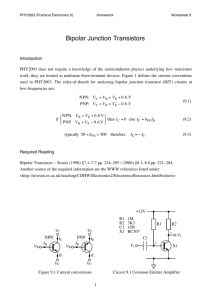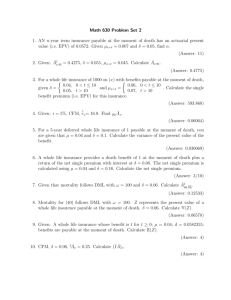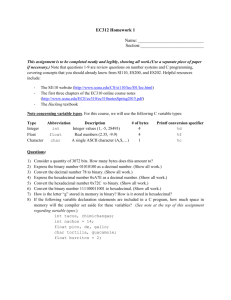-Ur
advertisement
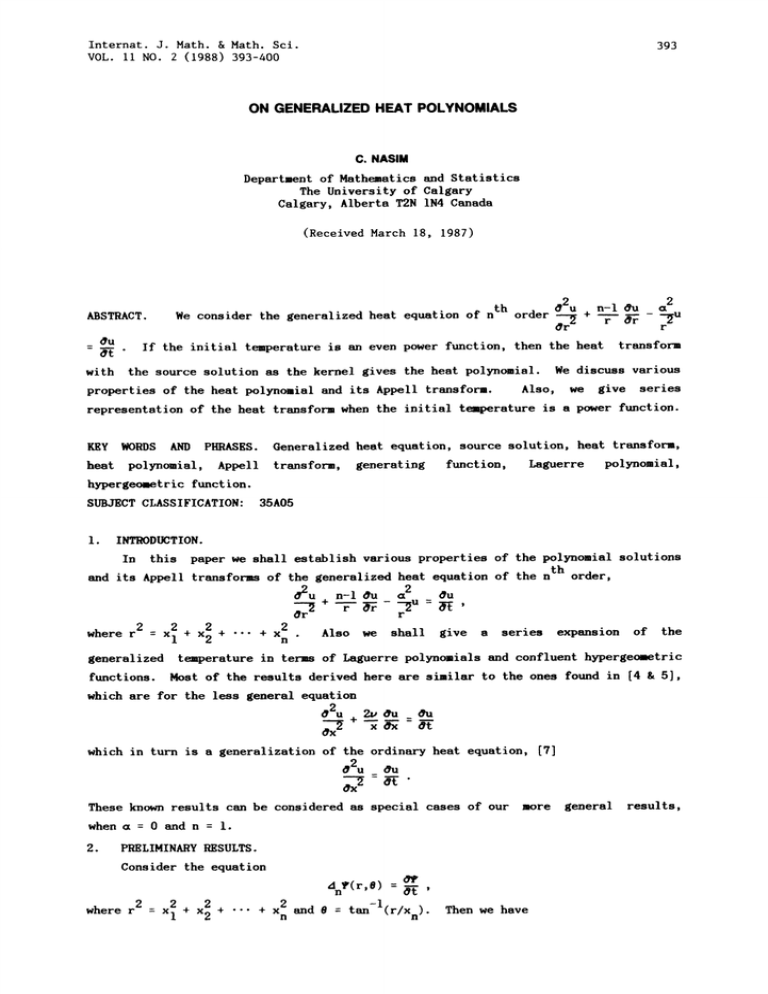
Internat. J. Math. & Math. Sci. VOL. ii NO. 2 (1988) 393-400 393 ON GENERALIZED HEAT POLYNOMIALS C. NASIM Department of Mathematics and Statistics The University of Calgary Calgary, Alberta T2N 1N4 Canada (Received March 18, 1987) We consider the generalized heat equation of n ABSTRACT. @__u th @2u @u + n-I r @r then the heat If the initial temperature is an even power function @t order 2 a -Ur transform the source solution as the kernel gives the heat polynomial. We discuss various Also, we give series properties of the heat polynomial and its Appell transform. with representation of the heat transform when the initial temperature is a power function. KEY WORDS heat AND Generalized heat equation, source solution, heat transform, function, transform, generating Lauerre polynomial, PHRASES. Appell polynomial, hypergeomet ric function. SUBJECT CLASSIFICATION: 35A05 I. INTRODUCTION. In this paper we shall establish various properties of the polynomial solutions th order, and its Appell transforms of the generalized heat equation of the n 2 @u a @u n-1 + br 2u where r 2 2 + Xl 2 + x2 + x2 n --r r Also we --u r shall give a series expansion of the temperature in terms of Laguerre polynomials and confluent hypergeometric funct ions. Most of the results derived here are similar to the ones found in [4 & 5], which are for the less general equation general ized @2u - x @x which in turn is a generalization of the ordinary heat equation, [7] @2u a-x @u These known results can be considered as special cases of our 0 and n when a 2. I. PRELIHINARY RESULTS. Consider the equation more 4 F(r,S) n where r 2 2 x + x I + + x 2 and 8 n tan- l(r/Xn) Then we have general results, 394 C. NASIM 1 sinn-20 r2s inn.- 20 Suppose the solution is of the type r(r,S) u(r,t)p(S), then p(S). Letting 1 n--2.dp d 2 p()sin_2 [stn ] (2.l) we finally have 2 -u 2u @u a -u r @r .--+ or r where n 2u + I, the generalized heat equation. d l n-2 0 dp } sinn-2s [sin d2p or Let ] + (n-2)cot S dp cos O, then from above, we obtain d2p (1-r2)--- (n-1) dp (2.2) Now from (2.1), we have ._2p(O) - 2p 2 -a p d which has a solution 1 (_)-P’ (), p() where m l(n_3), a2 kind, [2,p.122]. (u-m)(u+m+l) and m Pu() is the Legendre function of the first Also by elementary methods [cf. 6], we can find the solution of (2.2) as u(r,t) U(s,r: t)u(s,O)ds, O where U(s,r:t) + a2 where kind. (2.2). -u e (s2+r2) u+ 1 s r [sr] I/[], (2.3) and I (z), the usual modified Bessel function of the first We shall call the functioon U to be the source solution of the heat equation If U is considered as the kernel, then for a suitable f, its heat transform F is defined by where k - + 1 rkF(r’t) u and F(r,O) fO U(s’r:t)skf(s)ds’ f(r), the initial temperature. of the heat transform have been given in [6]. rkf(r) Numerous properties We note.that its inversion is given by U(s,ir:t)(s/i)kF(is,t)ds. (2.4) 0 Suppose now that the initial temperature is the power function f(r) r m real and positive, then from (2.3), its heat transform, P m, y(r,t) f U(s,r,:t)sk+mds 0 r( + + 1) /’(.u + 1) (2.5) 1 (4t)mrk IF1 -m; GENERALIZED HEAT POLYNOMIALS -I, t > O, [8 p.394]. Hypergeometric function Thus giving solution a 395 of (2.2) involving the As a special ease, if 1F1 2n, n m 0,1,2,... then P2n,/(r, t) r.+p+l)r"+n+l) } [x2 n (4t)nrkLt-r2/4t)n n! (4t)nrkp=oZ p (2.6) [I defining the heat polomial of degree 2n in r and of degree n in t, nvolvin O, we have the special case given in [4]. Next we define the Apll trsfo of P m real d positive Laerre the If we let k polial. ,(r,t), Wm,(r,t) lp[,(r,_m t)] 1 the Green’s fction, is defined by where H U(s,r:t) and s +u+ r/t)k(s,r’t),= s2+r 2 tk-I M (s,r:t) 4 e [s] I 2(sr) (2.7) It c be seen readily that N (0 r’t)t -k Wm,(r,t) 1 P,(r,-t). (.a) -r/4t 1 therefore we c write W t-(m+p+l)e -r2/4t i (r,t) P (r,-t), I In thi Pn,(r,t) ectin 11 e etblih nd it lppeII trf reult vri 2n,(r,t). invling the fctin ging the is an ey matter to calculate the folling estites: P2n,(r,t) P2n (r,t)= L 1. For 0 x < m, t 2n+k) r O(r 0[] n > O, k+2n 0 Usin the ove (2 6) the definition of P2n, PF. 2n, estimates, note that the twice, we have, f (s,r:t)P2n (s,-t)ds n (_4t)n-p E r(,+n+l) F(y+p+l) p=O n 2 lntesral converses. f("+n+l) (-4t)n-P (p+p+ 1 p=O F U(s’r:t)sk+2Pds 0 [;1 P2p, p (r,t) N, usin$ c. NASIM 396 Z (-4t) p=O /’(#/P+] (-I) N conJ.der the nne r (#+m+l r(+n*l)(4t)n- n s s 0 f k+2n reduces to r d heBce The _ 0 d I if 0 (3.1) equation For 0 (3.2) .e. 0 P2n,p(r,t) < =, < f m Thearefore n. t < =, y < (3.2), k+ r inversion foula of (2.5) with m gives us x ti+mJ U(s,r:t)P2n ,( s,-t) derive a generating function for LEMA 2. (-1) p r i=O nner desired. r 8 p=m Thus the (4t) 2n. We now , 1 2 Z Y n=O Let t PR(X)F. > n P2n y(r,t) O. Z n=O r ry k I e l-4yt w- ,k=-u+. Using (2.5) and (2.3), we have n Y P2n,(r’t) Z Y n=O oU(S,r: t)sk+2nd s (R) U(s,r’t)s k Z n=O U(s,r:t) / (s2y) n n: ds skes2y 0 [8,p.394] as required. The interchange of summation and integration is valid since y) -y) -s -s k+v+ 2( 2( 0 If t 0 O, the result can easily be computed, since P2n,y(r,O) k+2n r < For t O, we use the fact that P2n,(r,-t) from its representation given in (2.6). for the case t > O. Now we give a generating function i 2n-k The lemma is then proved on the same lines as for W2n,/a(r,t), P2n,u(r, t). LEMA 3. For t_> O, Iz[ < t, and k tt- u + , the Appell transform of k n Z n=O (3.3) P2n,g(ir,t) W2n,(r,t) H(O,r’t+4z), (3.4) GENERALIZED HEAT POLYNOMIALS Note that P)OF. t. abso utely when [z[ z W2n,/( r 0 , as n teJ and hence the series converges Using (2.8), we have H(0,r’t)t-k n=0 1 W2n’(r’t) n=0 t) 37 (z/t) P2n,(r’-t) r l 2 k H,(0,r:t+4z), due to Lena 2 d ming e of the definition of H given by (2.9). If we expd the right hd side of (3.4) by Taylor series in pers of z, we have []k H(O,r: r t+4z) n=02 (4z)n n []n [[]kH(O r: t) On co=paring this series with the series on the left hand side of (3.4), we tain - n Hg(0,r:t)] 1 22"+Ir(+1) r(+) 0 (-lr(+l))n22nintegral representation for giving trsfo 1 u J(ru) u2n++le_t r du, (3.5) W2n,(r,t). Also we give other generating fctions Appell _r2/4t e for the fction P2n,(r,t) d its We shall simply write d the results, which c be W2n,y(r,t). proved folling a similar alysis as ed for the L 2 d 3 ove. L 4. For < t < d all complex z, 1 4tz 2 z 2n z r I (2xz). e Z nr(n+l) (r,t) n=0 P2n, 5. < For t < - d all cplex z, 2n k n=O nr(n+l) iortt property of the sets of fctions N we shall prove d sh tt they fo a biorthogonal syst. W2n,(r,t) TO. For t > O, P,(’-t)n,. (x’-t) ere i tge irdelt P. gin (.8), r(l)’ n P2n,(r,t) d 398 C. NASIM 10 H(O,x t)t -2n-" P2n,/a (x,-t)P2m,(x _t)x2Udx tm-n-/a-ln’m"(-4)m+n x2/a+l e -x2/4t 1 L/afX2]L/a[]dx, ntl’J f0 22/a+Ir(/a+l) x 2 m (3.6) due to (2.6). The integral on written as, [3,p. I88]. the right yp 22/a+ 1 t/a+ 1 0 handside of (3.6) with a change of variable can be (+./ ) t+ 22/a+l rr(n+l) e-YL/an (y) L/am (y) dy 6 Hence the right hand side of (3.8) gives, r (/a+n+ 1) tm-n m.’ (-4) "r(l) r (trtn+ 1 n; 42n -r(u,1) as required. Next P2m,/a (x, we shall t)W2n,/a(x, LI 6. establish For x, y, s and t generating function for the > [z2t[ 0 and < biorthogonal Note that the series converges estimates of the functions and P2n,/a W2n,/a < s, the using (-1)n y 2mn’.r(/a+n+l) :Z n=O due to (3.5), 1 - u/a+l 2y 1 2 +l z-/a(xy) 1 (xy) 2t e P2n’/a(x’ t) -su u f0(2/a)/a+2n+l e -su2 J/a(yu)du, I J (yu)du 2 ’n’:(+l) /a n=O ue -u2(s+z2t) J/a(xuz)J P2n,/a (x’t) (yu)du y2+x2z2 z-/a e4( I " ]k (xz’y:s+z2t)’ ts+z2t H/a [l,p.511. s+-- 2t) fxy due to the definition in (2.7). Now two results on finite sums involving the functions For t n Z m-O > O, > O, /a By (2.5), z tn-m (-I z m=O 0 m k m P2n,/a(r,t) fn+.] z2n, m tn-mj (-l)m m=O P2n,/a and and a complex z, (-l)m fn+/a] *’:’ n PF. asymptotic therefore, P2n,/a (x t )W2n,/a (y,s) n=O n.’ (r(+n+l) 1 +z Iz2t for ,y:s+z2t). 2n z LE 7. set s, xy P2n,/a(x,t)W2n /a(y,s)/= 4z2t n=O n.’r(/a+n+l) PROOF. a t). in-m] z r (1-4tz) r, t m U(s n m m=O m r’t)sk+ds n-m 2 nLnftl-4ztJ zr W2n,/a. GENERALIZED HEAT POLYNOMIALS U(s,r:t) 0 sk LY(zs2)ds n 2 -r 1 -[ r r 399 s/+I e zr2 k( l-4tz) n L"[ n "’’t,-zJ sr I (zs2)ds L [I, p.43], as required. A similar result can also be proved involving LEMMA 8. > 0, For t n Z (-1)m ’&’; m:O > [n+"]zm W2m,a(r’ tn-mj 0 and a complex z, k t t) 241(+i) W2n,. n++ I (t+4z) nL t(t/4z) SERIES REPHESENTATION In this section we shall establish a series representation of the heat transform F(r,t) in terms of Laguerre polynomials and confluent hypergeometric functions. As mentioned earlier, for a suitable f, its heat transform F is given by 4. where F(r,O) f(r) THEAOREM: rkF(r,t) emd rkF(r,t) If f(x) has a growth I, u ;0U(s,ir:-t)(s/i)kf(is)ds, 0U(s,r:t)skf(s)ds, > 0, then 0 < t < 0 < t < o I u + ][ /a PIKX)F. If 0 < t < 6, we have rkF(s,t) Z a s n ds fo U(s,r:t)sk n=O n a n=O n Z a n:O n due to (2.5). JO Pn,ta(r,t), ; [U(s,r:t)sk+n[ds ; t(s+r)2 < < t e s k++n+l/2 ds 0 < . < 0, U(s, ir:_t)(s/i)kf(s)ds 0 ; U(s,ir:_t)(s/i)k 0 n-O Z a i n a n= 0 due to (3.3). "| U(s,r’t)sk+n ds The interchange of summation and integration is valid since 0 Also, if-6 > 0, t is a solution of the generalized heat equation Z a n=O n rkF(r,t) where k U(s,r:t)skf(s)ds, 0 Hence the result Furthermore, for 0 < ltl < 8, n n-k _ Z an(is)nds nO f U(s,ir:-t)sk+nds , n-k P n, (ir,-t) Z a P (r,t), n=O n n, c. NASIM 00 rkF(r,t) a n=O P n n, (r,t). Or rkF(r’t) n=O a2n P2n (r,t) + n=O a2n+l P2n+l,(r,t). Now making use of the definitions given in (2.5) and (2.6), we obtain n+ r(.+n+) n n=O giving r t n=O us a representation involving Laguerre polynomial and confluent hypergeometric function. If we set 0 i.e. g u 1 and k’= O, throughout, most of the results derived here, reduce to known results given in [4] and [5]. n Further, if we set O, u i.e. I, the results coincide with those derived in [7]. This research ACKNOWLEDGEMENT. is partially supported by a grant Natural from Sciences and Engineering Research Council of Canada. et al. "T__le__s_of I.n_tegral__Transformsj Vol. 2", Mc Graw Hill, Toronto, I. ^1954.Erdelyi 2. A. Erdelyi et sl. "Hi_her Transcendental Fun_c.t_io_n_s, Vol. i", McGraw Hill, 1954. 3. ^1954.Erdelyi 4. D.T. Haimo, "Expansions in terms of generalized heat polynomials and Appell transforms", J. Math. & Mech. Vol. I5, No. 5, (1966), 735-758. 5. D.T. Toronto, et al. "H_h__er_.Tr_an.scenden_t@l Functions, Vol. 2", McGraw Hill, Toronto, Haimo, "Series expansion and integral representation of of their generalized temperataures", Illinois J. Math. Vol. 14, No. 4, (1970), 621-629. equation", Proc. Edinburg 6. C. Nasim and B.D. Aggarwala, "On the generalized heat Math. Soc. (1984), 27, 261-273. 7. P.C. Rosenbloom and D.V. Widder, "Expansions in tearms of heat polynomials and associated functions", Trans. amer. Math. Soc., Vol. 92 (1959), 220-266. 8. G.N. Watson, "_Theor Cambridge, 1966. of Bessel functions", Second Edition, University Press,

